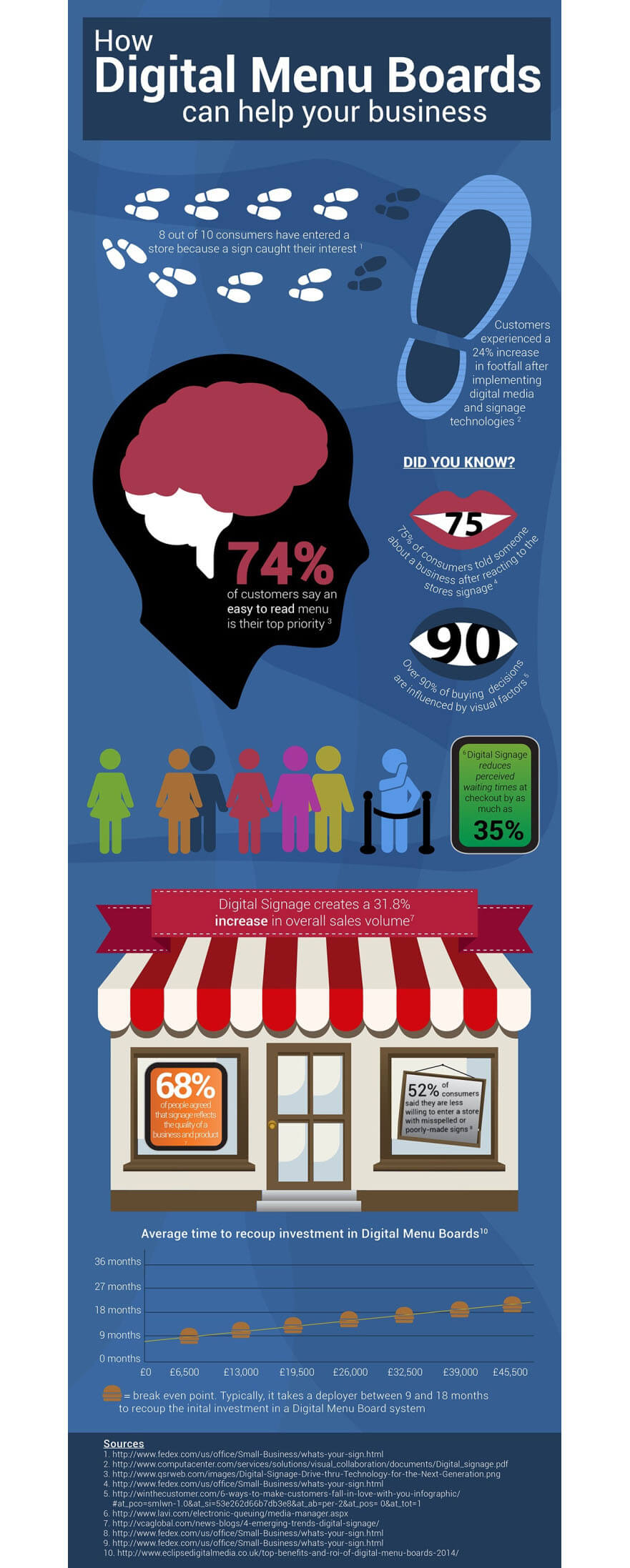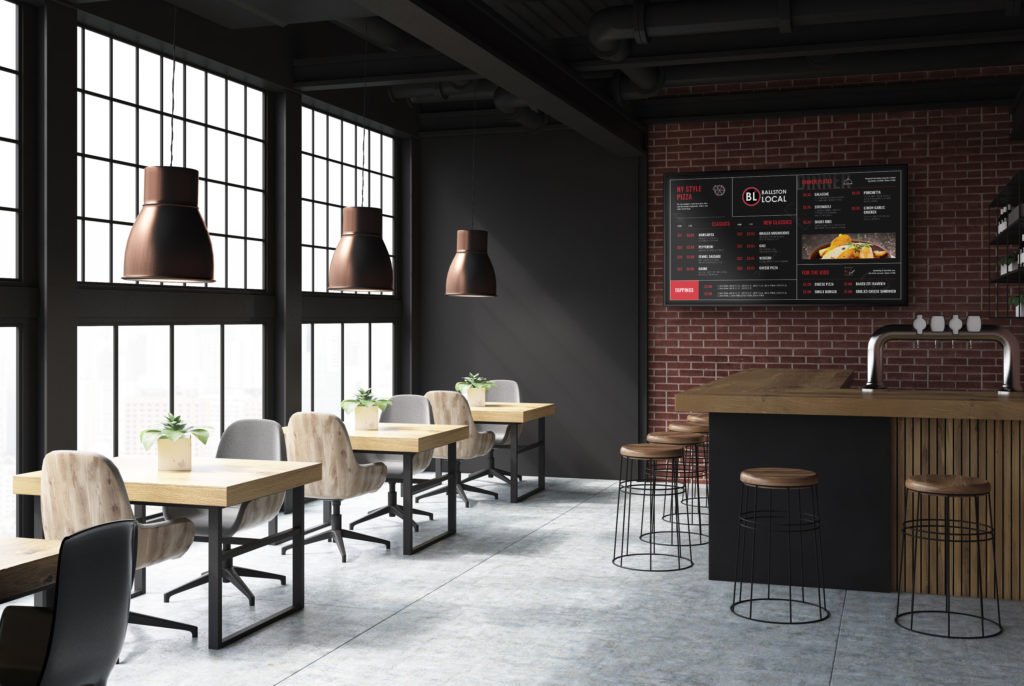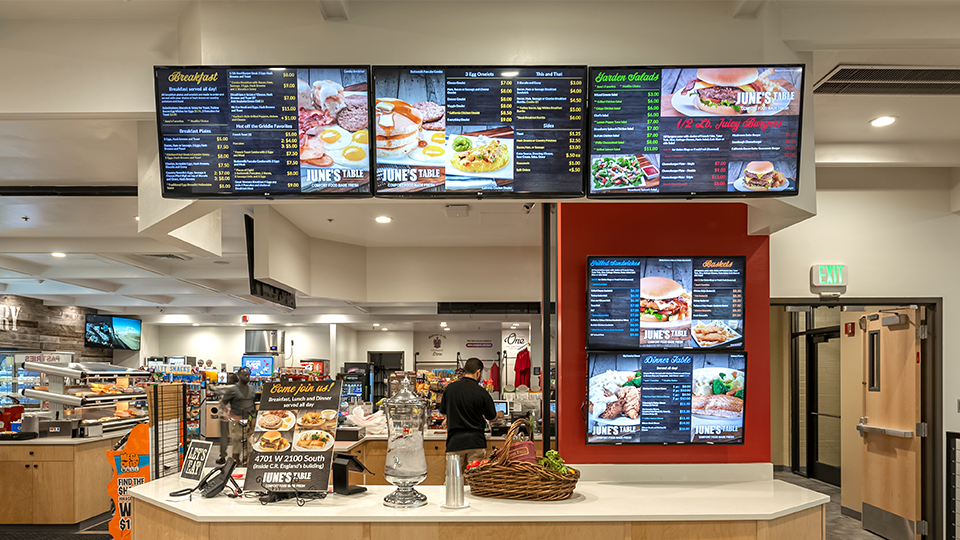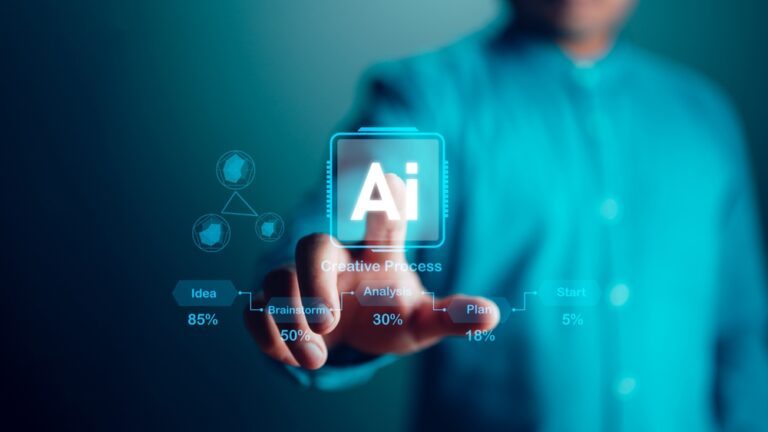How Do Digital Menu Boards Work? Everything You Need to Know (Cost, Design & Benefits)
What is a digital menu board?
A digital menu board is a display system that comprises hardware and software to display dynamic menus on screens. In addition to menus, the screens can also display specials and promotions, live TV, customer reviews, and more.
Are digital menu boards effective? The benefits of digital menu boards

Digital menu boards are highly effective. 74% of restaurant customers say an effective menu display is their top priority. With digital signage, you can instantly update, change, or schedule your menus. This also can help highlight specials as well as reduce costs for replacing your menu displays.
The benefits of digital menu boards are:
- Digital menu boards create a 31.8% increase in sales.
- Easily changeable and can typically feature menu regulations (including ingredients). Since most customers today are conscious of these regulations, you can, therefore, expect such information will become more prevalent in the future.
- Helps you start and end your marketing campaigns on time. As well, you can save on time and staffing costs because this solution enables you to access these features remotely. Equally, it also allows your on-site staff to concentrate on core duties.
- Since digital menu boards are both attractive and dynamic, they support the positive association with your brand.
- This platform affords your restaurant effective up-selling (of new add-on side items or desserts). This effect is due to the ease with which it attracts attention to promotional content.
- The scalability of digital menu boards simplifies logistics, allowing restaurateurs to centralize management. This also enables you to coordinate updates through cloud-based online dashboards.
- Digital menu boards afford decision-makers substantial flexibility with their local promotional content.
- Also, the solution enables restaurants to remain compliant with FDA menu requirements.
Simply put, restaurant digital signage avails a cost-efficient solution that enables restaurants to keep their menu pricing, promotions, and content up-to-date and consistent.
Indoor vs. Outdoor Menu Boards
Digital menu boards can be installed inside of a restaurant or outdoors for drive-throughs. While the content displayed is the same, the considerations of an outdoor menu board are different from those of an indoor one.
Considerations for Outdoor Menu Boards
Outdoor digital signage, especially for restaurants & eateries, has unique features and implementation demands that often result in hefty prices.
- Weatherproofing to shield the hardware from adverse environmental elements
- High-brightness screen provisions to cater to the visibility of content in sunlit conditions
- Securing the screens against vandalism or display damage
For the above reasons, the traditional indoor digital signage design is significantly different from an outdoor sign.
How do digital menu boards work & what are the components?
Essentially, digital menu boards work like most other digital signage projects. This solution combines the software (content management system), the hardware (digital signage player/display), & the content. This will mostly contain your menus but you can also put your branding or daily specials.

Before you launch your digital signage project, you’ll need the following:
1. Hardware
Digital displays—these consist of a screen with an HDMI port. Commercial-grade displays are ideal options due to their more extended warranties, longer hours of operation design, and durability. More so, they meet the brightness requirements and are also suitable for commercial environments. Another advantage these screens have is their support for both vertical and horizontal orientations.
Media player—this device downloads menu content from the software, and stores it internally (caching) before displaying it on the screens. You’ll use HDMI cables to connect this device to the digital displays. And for the media player to receive, and download content from the software plus transmit the media to the screens, you’ll need an internet (wired) or WiFi connection.
2. Software
Digital signage software is also referred to as content management software (CMS). The CMS is the command center of the digital signage solution. It allows you to create content, upload it, and subsequently configure and deploy it to digital displays.
Mostly, the software is cloud-based, and you’re able to access it online from a PC. Owing to this trait, you can effectively use remote content management to run your operations.
3. Content
This is probably the most intriguing element of digital signage. It’s what you end up displaying on the cafeteria’s digital displays. Furthermore, your target audience will interact or engage with this content. As such, content is perhaps the single most crucial factor that drives the success of a digital menu board campaign and helps you achieve an excellent ROI.
Based on the above notion, it’s critical to optimize the content you display on your screens by ensuring it’s easy to follow and meaningful to your audience. Content comes in the form of images, videos, PowerPoint presentations, digital signage widgets, and more.
Inherently, digital menu boards function relative to the effectiveness of the CMS they run on. So, let’s highlight some of the essential features you should look for in digital menu board software.
- Cloud-based digital menu board software—by having a CMS solution you can access via a website, it becomes relatively easier for you to edit or update your content.
- Customizable—the design of your digital menu board templates matters because it influences your audience’s visual perceptions and also reflects on your brand.
- Ease of use—the onboarding process should involve a relatively short learning curve for the end user. Also, it must be easy to implement—meaning it should allow restaurateurs to make price changes or add new items seamlessly.
- Menu scheduling—the CMS should afford a restaurateur the ability to pre-schedule various menus to run at different times or dates. This function should also simplify the process for the end user.
- Support—because a cafeteria or restaurant relies to no small extent on the menu, you should ensure the CMS provider guarantees full training as well as live person phone support.
How to design a digital menu board
As the designs you are making will be digital there are a few things you should keep in mind. These include the font style & text, images, or movement. The best way to determine what you need to design are:
- Find the display that works best
- Choose how you want the design done
- Choose your font size/style/colors and backgrounds
- Add your brand
- Finish with some flair
1. Find the display that works best
Just like choosing the tv that fits best in your home, you’ll want to find the display or screen that gives you the maximum ROI for your digital signage. Put yourself in your customer’s shoes and find where they will be looking while standing in line. You’ll want to find out what screen size would work best through a screen guide.
2. Choose how you want the design done
There are generally two options for how you can create your digital menu board. The first is by using a professional designer to create the menu to your specifications. The second is through pre-made templates that you can just add the item and price. Both have various benefits and cons so it’s important to find which one best fits your needs.
3. Choose your font size/style/colors and backgrounds
When it comes to fonts, you’ll want to pick the size and type that will be easy to read from both up close and far away. The colors should match your branding and not be hard to read. The background should also complement the menu items to make them easier to see and more attractive.
4. Add your brand
If you have an attractive design, be sure to add your brand to the display. This can help customers recall where they shopped and will leave a positive impact.
5. Finish with some flair
Once you have a good idea of where your menu items and pictures will go, decide if some flair is right for your customers. Change your specials into an animated gif to make them stand out more. Or use a social media content app and show off photos from your customers. Just make sure not to have too many moving pictures as too much movement can distract or confuse customers.
Design Tips for Digital Menu Boards
Studies show bright signage that includes photography and animations is more effective in drawing people to your menu offerings. Basically, trendy colors, optimal font size, and contrast improve readability.
From proper image choices to structured designs, it’s important to create practical and visually appealing layouts. This strategy enables you to improve customer experience and also helps you sell more.
1. Invest in good images but keep them realistic
Avoid the pitfalls of heavily filtered or stock images in your restaurant menu board design. A stock image denotes a generic image.
For instance, if you decide to use a burger or coffee cup that your customers actually can’t connect with, it may end up creating confusion about what you’re selling. As such, if you need to use imagery for your digital menu boards, always try to take your own.
Realistic images comprise food and drink photos taken in natural daylight while avoiding the use of flash because this can flatten your images by removing natural shadows.
Also, pay attention to the backdrop—an immaculately clean white diner plate on a patterned/ lightly colored table mat can perform better in terms of the look and feel of your restaurant’s meals.
Finally, reflect on your angles. How do you style and photograph your dishes? Certain dishes or drinks may look amazing when photographed from above, yet others may need a lower angle.
2. Add color
This consideration will mainly depend on your restaurant’s décor. For light spaces, opt for a dark screen because it’s an excellent way to attract attention. Conversely, go for a white screen if your space is brightly colored.
Also, it’s standard procedure to stick to only three primary color schemes to ensure your digital menu board doesn’t divert attention from the key message—your food!
3. Fonts
When selecting fonts, you’d want to consider brand guidelines as your measuring tool to suit the overall look and feel. Apart from the font size, another consideration would be the clarity of the headlines alongside the text.
Determine how far your screen will be from the furthest end of your audience’s queue. If on the assumption the viewers can’t read it, then you’d be passing up an opportunity to capitalize on the long queue time to sell more products.
4. Do not clutter—add space
In cases where you have many food items, it’s generally a daunting task to design restaurant menu boards without exhausting all the space. Nevertheless, this often results in the creation of crowded and “noisy” menu boards
To avoid overwhelming your patrons, you should allow for adequate breathing space—even if this means you have to create more than two menus. As such, you can separate courses or rotate menus to ward off having to stuff them in one place.
Also, the use of negative space around each list enables your customers to read the menu items or content easily. Hence, we recommend no more than 35 lines per slide. This ensures your viewers can read pricing as well as understand names. Thus, reducing queue time plus making sure your customers take less time to get to their food.
For large sizes, use sans-serif fonts to ensure viewers can read the messages at a glance. Similarly, avoid using multiple fonts, and bright, garish-colored fonts, especially when you have color across your design.
5. Add motion
We’re talking animated images or videos.
These elements work well towards attracting the eye as the human eye is naturally attracted to movement.
6. Include a Call To Action
A digital menu board serves the purpose of enticing customers to act. Bearing that in mind, it’d be easy if your customers are already aware of what they want. But if they don’t know, it’d be appropriate to take advantage of digital menu boards as a way to get your audience to ask.
Examples of CTAs include “ask us about our specials” Or, “like us on Facebook to get $$ off!”
These resulting calls to action allow customers to embrace your restaurant’s messaging.
Typically, you should display the call to action throughout; else, repeat it periodically until it sticks in your viewers’ minds. It’s ideally better to create a CTA that gets your customers to act instantly while in the queue, or soon after their meal.
How much does a digital menu board cost?
The cost of digital menu boards is usually broken down into three separate parts. The software will either be a subscription or a one-time cost. The hardware is your media player and display. Overall, you can expect the starting costs for one display to be $300 to $400.
Other costs to keep in mind are the displays you choose. Suppliers offer either consumer or commercial displays with commercial being the more expensive. Your digital signage provider can help you figure out which option you should choose. Installation costs should also be kept in mind. These vary greatly on if you hire a professional or do self-installation. Lastly, you’ll have to think of the costs of menu design if you choose a professional designer.
The total costs of implementing a digital menu board vary greatly based on the size of the project as well as the hardware you already have. The average final cost of starting from scratch for just one display is in the $500-$700 range. After this, the cost increases for each display you add.
Our conclusion/Final points/Key takeaways
As an attractive and welcoming restaurant branding solution, they’re an essential part of your marketing campaigns. Since they’re instantly recognizable, digital menu boards make your menu items more appealing; striking a chord with your customers, besides informing them they’re making the right choice.
Overall, digital menu boards have surpassed the “nice-to-have” business consideration—and are now perhaps a “must-have” for leaders in the restaurant industry.
If you are spending excessive amounts of money updating your menu or are concerned about the cost of printing promotional posters then running an effective marketing campaign holds the key to retaining and attracting new customers in the restaurant industry.
FAQs
Should I get a commercial or consumer display?
This will depend on your needs and budget. A consumer display will be cheaper but will often come with lower hardware capabilities. This can include lower brightness, lower resolution, lower warranty, larger bezels, and more. Commercial displays also have a longer lifespan so you can save on costs in the long run.
What are the benefits of professional designs?
Just like any other marketing material, it can cost you more in the long run to have a cheaply made design. Outside of the service and food, the presentation of your restaurant has a large impact on bringing in customers and getting repeat ones. Professionals have a great idea of how to present menus to give you a maximum ROI.
Does Mvix provide designer services?
Mvix has a team of designers who have the experience to create a unique and eye-catching template for your restaurant. For more information be sure to check out our professional design services and design gallery to get an example of the templates we’ve designed.




